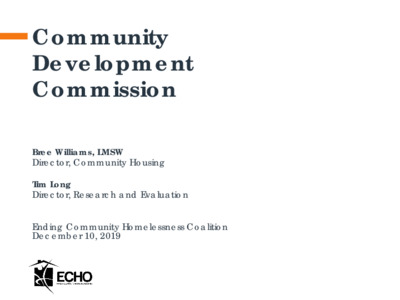Item 2B-Homelessness Initiatives(presentation) — original pdf
Backup

Community Development Commission Bree Williams, LMSW Director, Community Housing Tim Long Director, Research and Evaluation Ending Community Homelessness Coalition December 10, 2019 Factors Contributing to Homelessness Inadequate Support Services Economic/ Environmental Factors Foster Care/ Criminal Justice Involvement Lack of Family or Support Networks Ending Community Homelessness Coalition | 1 Our System to Prevent and End Homelessness Identification & System Entry Points Street Outreach Service Providers Health Institutions Schools Police/Prisons/Jail Child Welfare System Diversion Self-resolution Financial Assistance + Supportive Services Rapid Rehousing Permanent Supportive Housing Temporary Emergency Placement Shelter or Transitional Housing Coordinated Entry Prevention Services Ending Community Homelessness Coalition | 2 System Components to End Homelessness OUTREACH & SHELTER HOUSING & SUPPORT SERVICES COMMUNITY COMMITMENT ADDRESSING DISPARITIES EFFECTIVE SYSTEM RESPONSE Ending Community Homelessness Coalition | 3 Action Plan to End Homelessness The Austin City Council endorsed Austin’s Action Plan to End Homelessness in April 2018. We need your support and the funding to implement it to end homelessness. Summary of Solutions: Outreach + Shelter Housing + Services Addressing Disparities Effective System Create new small shelters Use outreach & shelters as bridges to housing Reunify more families Connect more people to housing Connect more people to jobs, healthcare and benefits Address root causes of homelessness Address disparities among populations experiencing homelessness at greater rates Improve system performance & outcomes Engage more stakeholders in system Community Commitment Create sustainable funding Gain community-wide support Ending Community Homelessness Coalition | 4 Current Situation: 3,066 Households Experiencing Homelessness Recommended Interventions based on Vulnerability Assessment Score Level of Need High 1,015 (33%) Moderate 2,051 (67%) Permanent Supportive Housing • Permanent Housing Voucher • Individualized, Voluntary Services • No Time Limit • Focused on building independent living skills and connecting clients with community resources Rapid Re-Housing • Rental Assistance • Individualized, Voluntary Services • Time limited • Focused on increasing self-sufficiency Source: By-Name List Ending Community Homelessness Coalition | 5 Population Demographics Gender Identity 0.33% 1% Household Size 4% 13% 42% 57% Male Female Transgender, Gender Non-Conforming No Data Source: By-Name List 83% Single 2-3 4+ Ending Community Homelessness Coalition | 6 Population Demographics Age 44% 44% 50% 45% 40% 35% 30% 25% 20% 15% 10% 5% 0% 8% Under 25 25 - 44 45 - 64 Source: By-Name List 4% 65+ Ending Community Homelessness Coalition | 7 Population Demographics Subpopulations 27% Categories are not mutually exclusive 8% 4% 11% 30% 25% 20% 15% 10% 5% 0% Chronically Homeless Families with Children Veterans Unaccompanied Youth Sources: By-Name List; Point in Time Count Ending Community Homelessness Coalition | 8 Population Challenges Inter-related health, social, and economic challenges often make it difficult for people to end homelessness on their own 50% Report being unable to take care of daily needs like food, bathing, and restroom access 38% 64% Report currently experiencing mental health issues Report having no planned activities that bring them happiness 62% Have dual or trimorbid health conditions Report having legal stuff going on that may result in Report having experienced domestic violence in their 42% lifetime 60% any income Report they do not have 12% Report that drug or alcohol use will make it difficult to maintain housing 46% jail or fines Source: By-Name List Ending Community Homelessness Coalition | 9 Are People Traveling to Austin? Most folks experiencing homelessness in Austin first began experiencing homelessness in Austin. The next largest group identify Texas as their point of origin. Where did you become homeless? Austin Central Texas Don’t Know/Refused Foreign Country Other Part of Texas United States 2016 2017 2018 2015 2019 68% 55% 61% 54% 61% 0% 4% 0% 2% 1% 0% 16% 13% 10% 16% 20% 11% 11% 15% 15% 17% 5% 10% 0% 6% 15% 0% 8% 5% 0% Note: In 2019 Central Texas was not a survey response option. Source: Point in Time Count Ending Community Homelessness Coalition | 10 Large Disparities Exist in the Population The percentage of people experiencing homelessness who identify as Black/African American is much higher than the Black/African American percentage of Austin’s population in poverty. All People All In Poverty (ACS) 69% 11% 0%5% 14% Experiencing Homelessness (PIT) Experiencing Unsheltered Homelessness (PIT) Experiencing Homelessness (PIT) Experiencing Unsheltered Homelessness (PIT) 55% 60% 37% 2% 1% 4% 33% 3% 0% 3% In Families with Children 50% 41% 1% 2% 6% 100% 0% 0% 0% 0% Source: Point in Time Count Ending Community Homelessness Coalition | 11 System Flow – Current Inflow Inflow > Outflow Persons Experiencing Homelessness Length of time persons remain homeless Outflow Exits to Housing Ending Community Homelessness Coalition | 12 System Flow - Desired Inflow Inflow = Outflow Persons Experiencing Homelessness Outflow Exits to Housing Length of time persons remain homeless Ending Community Homelessness Coalition | 13 Pay for Success Pay for Success is a set of innovative financing strategies that Pay for Success is a set of innovative financing strategies that make payments directly dependent on results make payments directly dependent on results Pay for Success strategies share these core principles: Clearly defined outcomes Data-driven decisions Uncommon, cross-sector partnerships Strong governance& accountability Private capital for impact Ending Community Homelessness Coalition | 14 Ending Youth Homelessness • Build and sustain a community system that ensures that youth homelessness is rare, brief and non-recurring by 2020. • This system is similar to the framework that now ensures that no veteran in Austin will be on the street for more than 30 days. • The system involves deep collaboration with dozens of nonprofit and public organizations – co-led by LifeWorks and ECHO. Ending Community Homelessness Coalition | 15